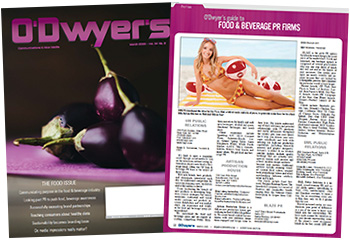 |
| Alexandra Oppenheimer Delvito |
Public relations and marketing campaigns have evolved over time, but frequently include the same traditional elements of traditional media outreach, social media activations, spokesperson and influencer partnerships, media and consumer events and advertisements. Reporters get hundreds of press releases and pitches every day. This familiar roadmap charts the course to PR success when personalized with creative themes, meaningful causes and attention-grabbing events. While these tried-and-true plays can score big wins for companies and brands, it’s important for food and beverage brands and commodities to look at additional marketing channels for opportunities beyond media.
 |
| This article is featured in O'Dwyer's Mar. '20 Food & Beverage PR Magazine. |
Marketing campaigns targeting foodservice—specifically school foodservice that reach kids in Kindergarten through 12th grade—provide a tremendous opportunity to food and beverage companies to enter new channels that drive volume sales. Every day, almost 100,000 schools or institutions serve school lunches to 29.8 million students. Reaching the K-12 market opens the door for commodities and brands to reach new audiences, introduce children to new foods and flavors and create a generation of consumers, all while increasing business.
Entering the school foodservice market is challenging, but with the right partner and strategy, your products can be on school lunch trays nationwide. Pollock Communications’ newly launched school foodservice division, On the Tray, is dedicated to executing impactful programs that reach our youngest consumers with healthy foods and beverages. Here are some tips from the On the Tray communications pros and registered dietitians who’ve executed award-winning school foodservice campaigns for clients:
Research makes perfect. Research is essential when entering the school foodservice sector—even with experience in foodservice, schools are a whole different ballgame. Set by the U.S. government, the National School Lunch Program and School Breakfast Programs have specific requirements and nuances that make planning meals extremely complicated. School foodservice directors and registered dietitians specializing in school foodservice are key resources—a reason Pollock Communications has registered dietitians on staff leading the On the Tray division—to help understand the opportunities and challenges for brands and commodities in the K-12 market.
Identify the influencers. It’s essential to identify influencers who will benefit from your upcoming campaign and can help provide boots-on-the-ground feedback that will guide content development and program execution. These influencers have decades of experience in school foodservice and hold positions within their state or professional organizations that make them leaders among other school foodservice pros. This relationship helps align your program with what’s most effective in schools while generating advocates on the frontlines of school meal planning and execution.
Speak the language. The right lingo is essential when creating content that educates school foodservice professionals about why and how to incorporate your products into school meals. Schools must provide meals with specific amounts of all major food groups. To put foods on the tray, schools need to know how your products stack up against the criteria they’re audited against. Experts, like the registered dietitians at Pollock Communications, have years of experience communicating how foods meet these strict guidelines and how schools can build them into their menus.
Know what matters most. School foodservice professionals are responsible for feeding kids nationwide. They face long, demanding hours and busy schedules, but their passion is unmatched. Not only do they have challenging requirements for their meal patterns, but they want to know they’re making smart, healthy choices to nourish their students. It’s essential to tell this audience why a food or beverage is so valuable for students and provide turn-key ways to put the item on the tray with standardized school foodservice recipes meeting National School Lunch Program guidelines. Focus on the right messages for the audience: include details about how foods meet food group requirements and help schools stay within required limits, like sodium. Talk about where foods are grown; schools are required to purchase U.S.-grown foods as much as possible.
Show up. Like school, attendance is mandatory at trade meetings like the School Nutrition Association Annual National Conference. This is an important annual event to be face-to-face with school foodservice professionals and share resources and recipes that help them add your product to their menus. You should have standardized school foodservice recipes, product sheets and well-informed registered dietitians staffing your booth to speak to the benefits of using your product in schools. Attendees are extremely knowledgeable and need to have all their questions answered in order to consider putting your product on the tray.
Test for success and publicize to the masses. Pilot programs are an opportunity to build relationships with schools, test your products among the students and measure successes that can be used as product testimony. School foodservice professionals want to know your products will work in their operation and in-school testing answers that question, creates new supporters and generates data that can be used to promote successes to trade media. Publicizing successes in trade media reaches the broader school foodservice audience with your product benefits and built-in endorsements.
The school foodservice market reaching K-12 students holds great potential for food and beverage brands and commodities to drive volume sales and build a new generation of consumers. Having the right partner that understands and has had success in this market can help clients enter the market with the best chances of success.
***
Alexandra Oppenheimer Delvito is a Registered Dietitian, Vice President at Pollock Communications and team lead of Pollock’s dedicated school foodservice division, On the Tray.


 What the biggest meal of the day can teach us about serving up effective nutrition communications campaigns.
What the biggest meal of the day can teach us about serving up effective nutrition communications campaigns. Tips to refine and amplify your CPG brand strategy to win in 2024 and beyond.
Tips to refine and amplify your CPG brand strategy to win in 2024 and beyond. Strategic communications strategies for success in the growing “food is medicine” movement.
Strategic communications strategies for success in the growing “food is medicine” movement. How brands can authentically communicate sustainability issues and create a brand experience that’s compatible with consumers’ values.
How brands can authentically communicate sustainability issues and create a brand experience that’s compatible with consumers’ values. Communicating the effects that climate change and a growing world population have on our food system—and why change is needed.
Communicating the effects that climate change and a growing world population have on our food system—and why change is needed.


 Have a comment? Send it to
Have a comment? Send it to 
No comments have been submitted for this story yet.